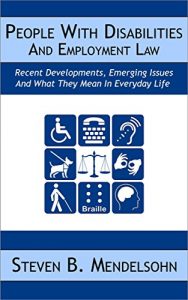Employment is an issue touching almost everyone's life. Sometimes, the subject has important legal dimensions. Is someone an employee or an independent contractor? What about overtime, privacy, medical screenings?
For people with disabilities, and for their employers, the legal issues become even more complex, including such civil rights issues as equal opportunity and reasonable accommodations. In facing these complexities, people with disabilities rarely have access to the specialized legal expertise necessary to help them understand their options or make the best decisions.
This book attempts to bridge the gap between workers with disabilities, their friends, families and employers, on the one hand, and the mysteries of the law, on the other. Using a narrative format, it tries to do so by identifying some of the key legal issues in disability employment that have emerged over the past few years.
In terms understandable to laypeople and nonspecialist attorneys, it explains what happened, why it is significant, and, perhaps most important, how it may prove useful in everyday life. Without glossing over the uncertainties, it makes the law more accessible to people who cannot devote their lives to following its changes and intricacies, but who may need to know something about it in order to increase their autonomy and problem-solving options.
For people with disabilities, and for their employers, the legal issues become even more complex, including such civil rights issues as equal opportunity and reasonable accommodations. In facing these complexities, people with disabilities rarely have access to the specialized legal expertise necessary to help them understand their options or make the best decisions.
This book attempts to bridge the gap between workers with disabilities, their friends, families and employers, on the one hand, and the mysteries of the law, on the other. Using a narrative format, it tries to do so by identifying some of the key legal issues in disability employment that have emerged over the past few years.
In terms understandable to laypeople and nonspecialist attorneys, it explains what happened, why it is significant, and, perhaps most important, how it may prove useful in everyday life. Without glossing over the uncertainties, it makes the law more accessible to people who cannot devote their lives to following its changes and intricacies, but who may need to know something about it in order to increase their autonomy and problem-solving options.



